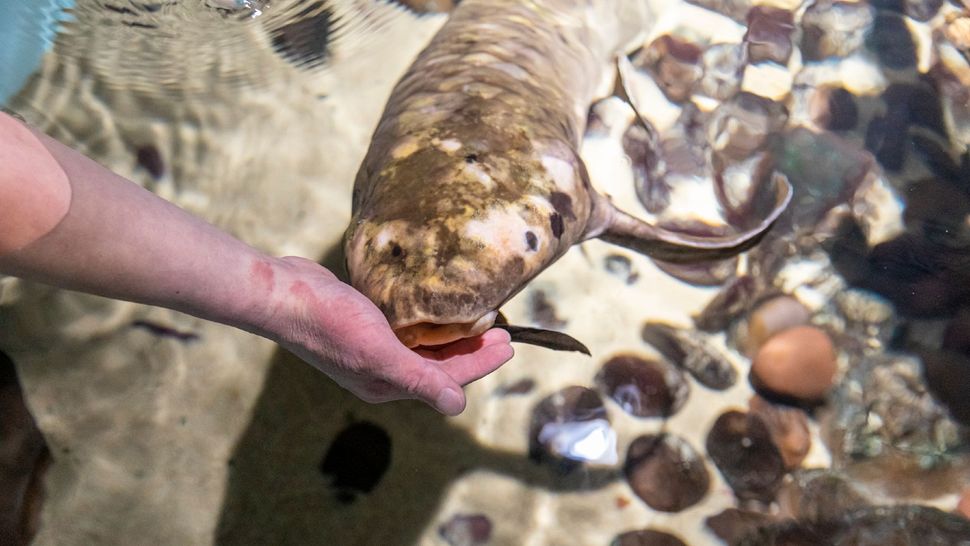A recent study reveals that Methuselah, the renowned Australian lungfish that arrived in the U.S. in 1938, might be an impressive 101 years old.
The world’s oldest aquarium fish, a lungfish named Methuselah, may actually be decades older than researchers originally thought and may even be over 100 years old, a new study finds.
Methuselah is a female Australian lungfish (Neoceratodus forsteri) that resides at Steinhart Aquarium in San Francisco, California. She first arrived at the aquarium in 1938 after being sent to the U.S. along with more than 200 other fish from Fiji and Australia.
Aquarium staff have never been sure how old Methuselah is, but until now the best guess was that she is 84 years old, which makes her the oldest known fish in captivity. (In the Bible, Methuselah was a man who reputedly lived to be 969 years old.)
The elderly fish, who loves belly rubs and is hand-fed figs by her doting keepers, shows no signs of slowing down, which has added to the confusion about her age. So researchers decided to work out exactly how old she is using a “DNA age clock.”
In the study, researchers compared Methuselah’s DNA to the genetic material of other Australian lungfish to work out how much wear and tear her DNA had accumulated. The results suggest that she is most likely age 92, but the level of uncertainty with this type of experiment means she could be up to 101 years old. The study will be published later this year.
“Although we know Methuselah came to us in the late 1930s, there was no method for determining her age at that time,” Charles Delbeek, curator of aquarium projects at Steinhart Aquarium, said in a statement. It’s “incredibly exciting” to have a better understanding of her actual age, he added.
The researchers compared the DNA of 30 Australian lungfish from captivity and the wild, including two other lungfish at the Steinhart Aquarium. The team analyzed the amount of methylation in the fishes’ genetic material. Methylation is a biological process by which methyl groups —a carbon atom bound to three hydrogen atoms — are added to the DNA molecule. From this, they were able to work out how long it would have taken for Methuselah to build up the number of methyl groups found in her DNA.
The researchers are unsure how long Methuselah could live for, but as more individuals are sampled, the DNA clock for the species will become more accurate and help unravel this mystery, study co-author David Roberts, a researcher at the Australian River Institute at Griffith University, said in the statement. But regardless of how long she will live for, there are no known lungfish older than Methuselah, he added.

In the untamed landscapes of Queensland, Australia, Australian lungfish navigate the capricious rivers exclusive to this region. These waterways, while prone to instability during dry periods, bear witness to the lungfish’s remarkable adaptability. As the rivers stagnate, depleting oxygen levels, these ancient fish defy the aquatic norm by rising to the surface, drawing breath through a single lung—an extraordinary feat that earned them their distinctive name.
Revered as “living fossils,” Australian lungfish have gracefully weathered the tides of time, retaining a striking similarity to their ancestors for millions of years. Fossils dating back approximately 380 million years, from the Devonian period, showcase the enduring legacy of the genus Neoceratodus. Amid the eons, these aquatic beings have carved a niche as resilient survivors, embodying a testament to the evolutionary stability that characterizes their existence.
However, the tranquility of their ancient lineage faces modern challenges. Human-induced alterations to their habitat, particularly through dam construction, pose a significant threat to Australian lungfish. The International Union for Conservation of Nature (IUCN) Red List of Threatened Species classifies them as endangered, underscoring the urgency of conservation efforts.
In this context, the newfound DNA age clock emerges as a beacon of hope for the preservation of this ancient species. Developed by researchers, including lead author Benjamin Mayne, a molecular biologist at the Commonwealth Scientific and Industrial Research Organisation (CSIRO) in Australia, the DNA age clock holds promise as a crucial tool for effective conservation strategies.
Mayne emphasizes the importance of accurately determining the ages of fish in a population, including their maximum age. This knowledge proves vital for the species’ management, offering insights into their longevity and reproductive capabilities in the wild. Understanding these aspects becomes instrumental in modeling population viability and reproductive potential—an indispensable foundation for the conservation of the enigmatic Australian lungfish.
As the currents of time and human impact converge, the application of innovative scientific tools, like the DNA age clock, offers a glimmer of hope for the survival of this ancient aquatic marvel. In the delicate balance between tradition and progress, the Australian lungfish continues to swim against the tide, a living embodiment of resilience facing an uncertain future.
